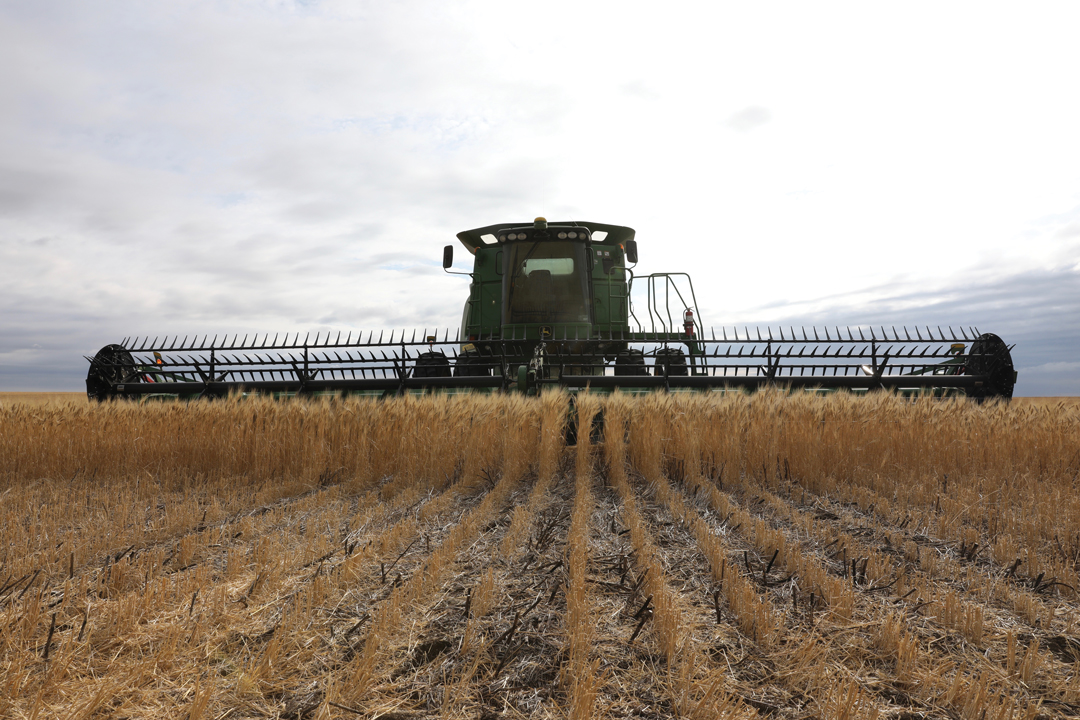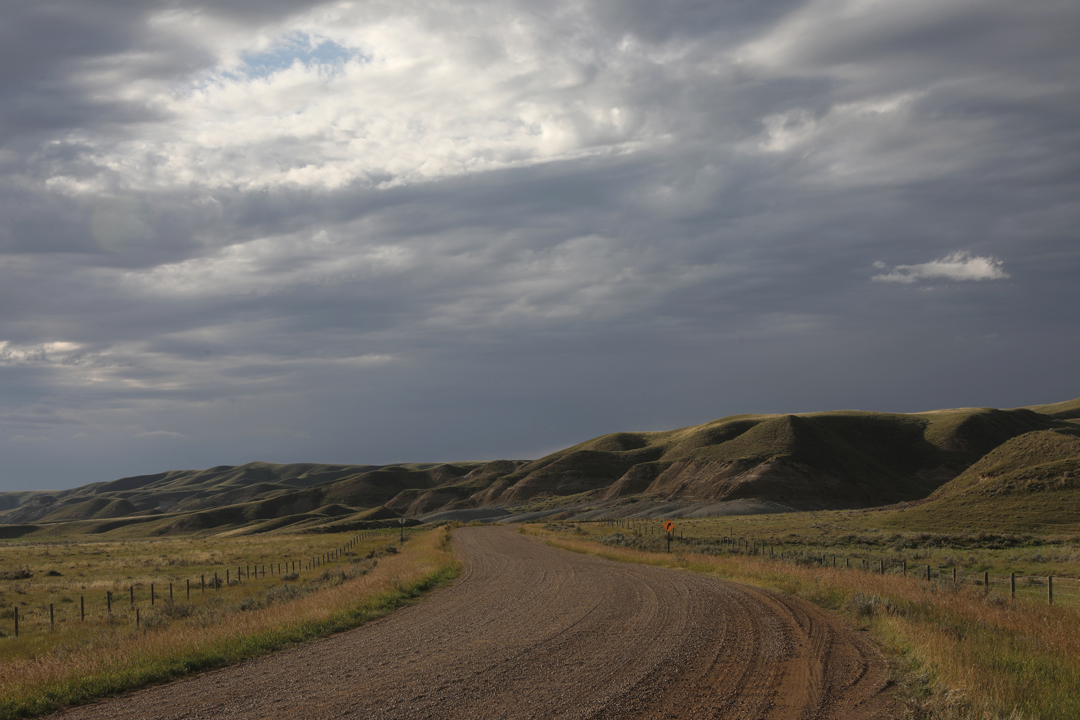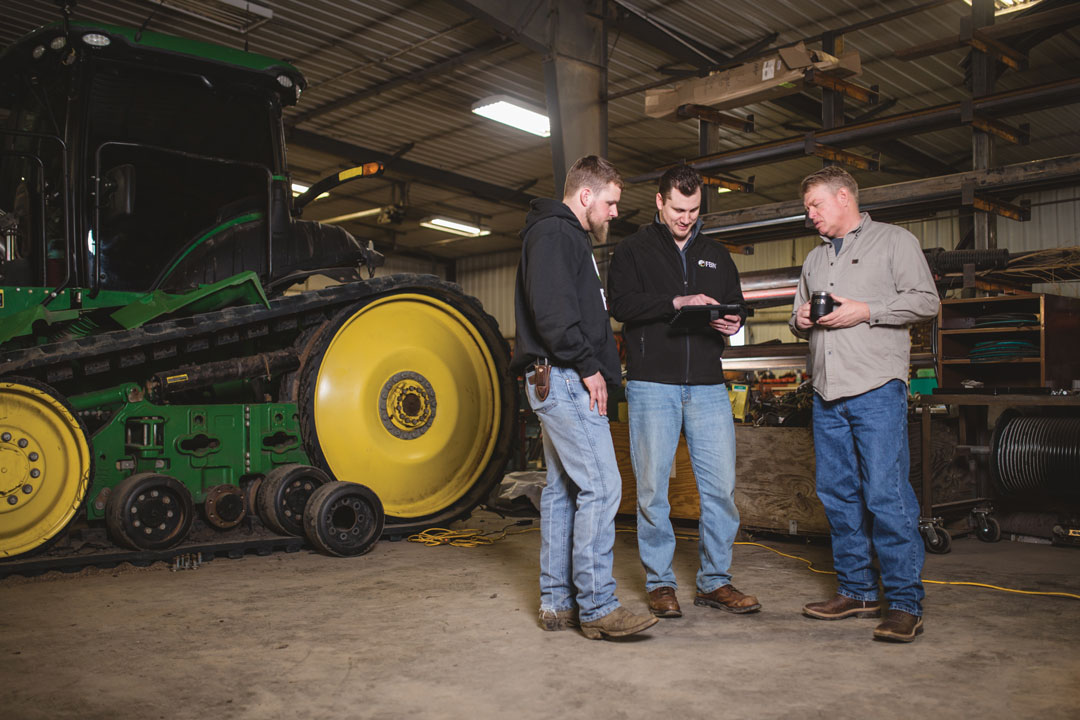SPECIAL CIRCUMSTANCES
BY CAROL PATTERSON • PHOTOS BY ZOLTAN VARADI
Blood dripped from Liz Roberts’s hand. She needed help but her cell phone showed no service. She stepped away from the fence stretcher that had gashed her hand. Driving to get medical help, she stopped several times to phone for assistance without success. From her family’s farm south of Cereal, Roberts arrived 30 minutes later in Oyen, a town of 1,000 hardy souls perched just south of Highway 9 in southeast Alberta, relieved to have remained conscious long enough to find a doctor and stitches for her wound.
Drawing on one’s own strength isn’t new for people living in Alberta’s Special Areas 2, 3 and 4. With a farm and ranch population of 4,184 in the 2016 census, this is about half the population of Banff spread over five million acres, or about one person per 1,000 acres. Even counting the roughly 4,000 townspeople of Oyen, Consort and Hanna, the Special Areas might be dubbed Alberta’s Empty Quarter for its sparsity of inhabitants. Though not quite as arid and unpopulated as the legendary Empty Quarter of the Arabian Peninsula, dealing with isolation is a way of life here, as is battling drought.
In the Special Areas, cattle and occasionally pronghorn dot large pastures and songbirds flit between grain fields. Wind-swept prairie and deep coulees wrap an unbroken horizon, the area’s history tucked away in homesteads and towns. The region’s western edge dips into the Canadian Badlands, its dinosaur fossils hinting of a long-ago age when moisture was abundant.
The Roberts family and their neighbours have come to terms with the difficult soil and climate conditions of this region, but many past inhabitants were chased away by the dust clouds of the 1920s and ’30s. Almost a century later, the residents of the Special Areas are role models for tackling drought and volatile climate conditions.

Above: Following the Great Depression, farmers and ranchers in the Special Areas adapted to the unique agronomic challenges they faced. Top: On a short break from harvesting their pea crop, Fred and Liz Roberts visit with daughter Candy and her baby Cazzlyn Bachmeir. The family farms south of Cereal.
SPECIAL RULES FOR SPECIAL AREAS
Lured by cheap land, people with big dreams flocked to southeast Alberta between the early 1900s and 1920s. Homesteaders hoped to break the land, but it often broke them.
Population in the area surged past 20,000, peaking in 1916 at about 24,500 but fell as newcomers discovered the land was poorly suited to the farming practices of the day. Worsening the situation, persistent drought conditions started in 1917. Many walked away from homes, mortgages and unpaid taxes, leaving towns and municipalities staggering under debt.
A provincial commission struck to tackle the problem produced the Special Areas Act. Passed in 1938, it gave administrative powers to the newly formed Special Areas Board including management of “tax recovery” land that had been abandoned with taxes owing. Some of the land was sold to area residents but much remains under the board’s governance.
The boundary encompassing the Special Areas is shaped like a jagged puzzle piece. From the Red River Valley in the west to the Alberta-Saskatchewan border, it also stretches from Highway 599 in the north to Canadian Forces Base Suffield in the south. Towns within the region are not covered by the Special Areas Act. Special Areas 1 once included land near Tilley and Cypress Country but the designation was removed decades ago.
The board put tax recovery land back into production, setting up large community pastures with user fees and leasing portions to farmers with the proviso native prairie not be cultivated. “The board on the public land side does not allow any breaking of undisturbed, uncultivated native prairie,” said Jordon Christianson, Special Areas Board chair. The one exception is select leaseholders who have established forage crops on previously cultivated land have been allowed to apply to cultivate them.
“There is a large component of the landscape not suited for farming; the best and most suitable use for much of it is perennial forage,” said Christianson. As a result, about one-third is cultivated, one-third is reseeded perennials—cultivated land reseeded for hay or grazing—and the remainder is native pasture. Farmers in the area align their activities with the land’s designated ideal usage.
UNIQUE GOVERNANCE
Eight decades after the creation of the Special Areas, governance remains different from other Alberta rural areas. Rural residents do not elect councillors for municipal districts. Rather, the region is governed by an advisory council comprised of elected representatives from each of 13 sub-districts. The council provides input to a four-person board that deals with day-to-day governance.
Some residents question whether special governance is still needed and the issue has been reviewed in recent years. “Redford and Prentice [provincial governments] looked at the governance model and asked, ‘Does it still make sense?’ They decided there would be no changes,” said Christianson.
A descendent of area farmers who arrived over a century ago, Christianson sees value in the governance model. “This form of government does make sense out here because of the dynamic between the public lands and the ranch and farm units and how things are set up here. The anomaly is that public land here is managed at a local level and that speaks to the success of the Special Areas.”
Perhaps the model works because the people governing it are local farmers and ranchers. “There’s so much time and history on the landscape,” said Christianson. “Intuitively, there’s a feel what’s going to work on a particular piece of land.”

One massive region subdivided into three parts, the Special Areas are so named for the land-use regulations introduced decades ago to conserve the farms and ranchland of this arid expanse of southeast Alberta.
FARMING THE SPECIAL AREAS
The soil on Liz and Fred Roberts’s farm is the shade of brown indicative of low organic matter and poor moisture retention. Compared to soils elsewhere in the province, it also takes longer to recover from compaction and other impacts. Special Areas farmers know succeeding with poorer soils requires a longer planning horizon and an acceptance that drought will be a regular visitor. Maintaining soil health is critical.
Now cropped with wheat, oats, barley, canola and field peas, the farm has been in Fred’s family for 104 years. What separates Special Areas farmers from those elsewhere in the province? “Patience, maybe,” said Fred with a laugh.
Liz concurred: “You can’t farm from year to year. You have to have a long-range outlook in terms of finances. If you have a good harvest one year, you don’t spend all your money, you put some aside whether it’s in dollars or seed so you have some means of getting through the next year because it could be a drought year.”
Fred’s grandfather, who homesteaded the land, kept the farm going through the Great Depression with his First World War pension. For a period of time, both Liz and Fred worked off the farm to keep it going. With improvements they’ve made in soil health, the farm now sustains the family. Their three adult children have moved away but all are landowners and help operate the farm.
Crop rotation has been critical to their success. “You might rotate over six years within a field,” said Liz. What works on the Roberts’s farm is two years of cereals followed by peas, cereals, canola and cereals. The cereal component can be oats, barley or wheat, depending on their economic needs and market demand. Different plants have different root zones. Going to a rotation, you take disease down and utilize different layers of soil.”
While they may have left land fallow in previous years, they now work it more intensively even with dry conditions. “In the last five years, we’ve gone through continuous cropping, which seems to be working. Three of those five years have been drought years and we’re still getting decent crops. Farming practices in general have changed enough it seems to be working for us,” said Fred.

CARA assists Special Areas farmers and ranchers in coping with challenging soils and moisture conditions.
LISTENING TO THE SOIL
Scientists at the Chinook Applied Research Association (CARA) are helping Special Areas farmers wring the most out of these stingy soils while improving their general health.
Founded in 1979, CARA was the province’s first broad based applied research organization that conducted crop, forage, conservation and extension projects. It was one of 12 groups that formed the Agricultural Research and Extension Council of Alberta (ARECA). Though the original 12 ARECA members continue to work together on farm initiatives and advocacy, CARA and five other organizations recently left to create the informal FarmRite group. These six partners now focus on advocacy and collaborative partnerships.
Dianne Westerlund grew up in the Special Areas and knows the challenges of the region’s wide-open spaces. “There is some isolation. We accept that if we want our kids to participate in sports or cultural activities, there will be windshield time.”
In her role as CARA manager and forage agronomist, she looks for ways to improve yields on the problem soils of prairie grasslands that typically receive light precipitation. “If you look at a soil capability map, most of our land is class three, four or five. I don’t know if we have any class-one land,” said Westerlund.
“This isn’t next-year country, but last year’s country,” she said. “If in 2019 you are overgrazing and it is compounded by dry conditions, next year, even with great conditions, [the land] may not be able to recover.”
Encouraging crop rotation, reduced tillage and better soil quality has helped farmers capture moisture more efficiently. Crop and soil health management specialist Yamily Zavala is CARA’s Soil Health Lab manager. Assisting farmers in improving the soil, she studies the stuff with the intensity of a teenager playing Fortnite.
Having worked in Venezuela and West Africa, she knew it was important to have her own laboratory, as sending samples out for testing is costly. Located adjacent to the main CARA facility, the lab opened in 2018. Here, Zavala studies soils from around the province, but she is particularly excited about solving agronomic problems in the Special Areas. “The soil [here] has low organic matter,” she said. “Will this area sequester more carbon than others? We don’t know, but it would be interesting to know.” What she’s certain of is, “healthy soil will capture more water and that will help with any drought.”
Zavala’s research is carried out in partnership with local farmers and ranchers. In one instance, a farmer with a soil compaction problem invited Zavala to plant an experimental mix of plant species to test its effectiveness as a remedy. She hoped the various varietals with their contrasting root lengths would reduce compaction.
“It was interesting to see that an area that was very compacted, in the next growing season the soil changed structurally.” The practice increased aggregation, the healthy formation of bonds within the soil. “In that short period of time [the mix] allowed that soil to regenerate in a faster way than expected,” said Zavala.
She stressed that although soils in this part of the province have more constraints, including low moisture, decomposition and organic matter, “with good management they have been made almost as productive as areas with fewer constraints.”

CARA’s Soil Health Lab manager Yamily Zavala emphasizes the region’s challenging soils can be quite productive with good management.
IMPLICATIONS FOR CLIMATE VOLATILITY
Farmers across the rolling grasslands and cultivated fields of this area have danced on the razor’s edge of survival for decades. They may have learned to thrive in this area that once drove many away, but with each census, the population in the Special Areas trends downward.
The Roberts’s daughter Candy lives in Calgary where she works as a chartered accountant. She believes farming in the Special Areas holds opportunity given the right approach. “You need to think outside the box,” she said. “Land costs have crept up in the last few years. You have to get things on paper and pay attention to the data instead of gut instincts.” Real estate investors appear to agree. In recent years, some have bought land in the area, at times contracting young farmers to run successful operations.
With a perspective earned from long hours working on the farm and through her financial experience, Candy recognizes the risks facing farmers but feels they can be managed with planning and understanding farm cost structures. “You have to be thinking about moisture. The biggest variable is the weather and you can’t control it, but with good plans in other areas you can mitigate the risk.”
Christianson agrees. “They [ranchers and farmers] have learned to live within the means of their environment. When years are good, people will not hesitate to put up as much as they can and carry it over for a year or two so they have something to lean on when times are tough. I think that’s why people have been so successful in Special Areas. They’ve adapted to that [climate] volatility.”
Good agronomic science and farming practices have enhanced soil health in the Special Areas, but a bone-deep commitment to long-term strategies underpins agricultural success. The people in the Special Areas are well positioned for climate challenges and their experience offers insight for their farming peers across Alberta.







Comments